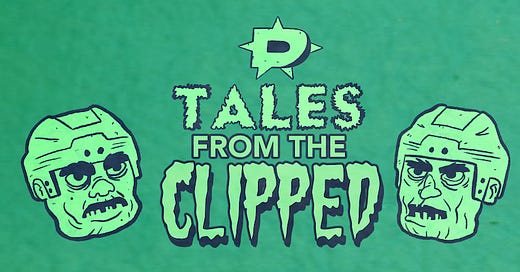Tales From the Clipped: Has Dallas' top prospect, Emil Hemming, finally arrived?
The film room says it's certainly starting to look like it.
My initial reaction to the selection of Emil Hemming was lukewarm given what I knew of the draft itself and who was available. So I didn’t like the pick, but I liked the player.
Broadly speaking, those fears were validated early on. Hemming started slow for the Barrie Colts. With seven points through the first 10 games, his start was fine, but nothing special. You would have liked to have seen more from a player who spent time in a professional European league (Liiga) going down in weight to the OHL, but come on—10 games. However, as the season progressed, Hemming didn’t just slow down. He went backwards. November was brutal, as he tallied just six points the entire month.
While it’s true that the Colts have been a poor-ish scoring team, Hemming had all the advantages of starting out on the top line with fellow 2024 first rounder Cole Beaudoin, with power play minutes on the top unit too. And for a time, the Colts were one of the best teams in the OHL. So the explanatory power of transitioning to North American hockey and being on a low scoring team seemed modest given how he started, how he was developing, as well as the context granted to him.
And then the World Juniors happened. Like his season with the Colts thus far, it didn’t start out well. But unlike his season with the Colts thus far, his finish in the tournament was stellar. He was arguably Finland’s best forward in the final two games versus Sweden and the US. And that’s starting to show up in his OHL games too, as he’s up to 35 points in 43 games.
Even at his “worst” I always made mention of the fact that that Hemming may not have been producing like a top prospect, but he was developing traits like a top prospect, with new wrinkles showing up in his passing ability and skating acumen as the season progressed. With seven points in his last three games (more than all of his month of November combined), now the two are starting to become aligned. Better yet, he’s been added to Barrie’s penalty kill. Needless to say, the coaches see his development too.
The points
Below are all seven of Hemming’s points over his last three games. Rather than go through them one by one, I’ve put together a mix with timestamps below.
0:00-0:06 Goal (power play)
0:06-0:14 Assist (overtime)
0:14-0:24 Secondary Assist (power play)
0:24-0:32 Goal (power play)
0:32-0:36 Secondary Assist (power play)
0:36-0:44 Goal (shorthanded)
0:44-0:58 Assist (even strength)1
Hemming’s shot was his calling card going into the draft, and he finally got it going it seems—now up to 13 goals on the season. I don’t think anything has changed on some fundamental level. Hemming looks like the same player, more or less. He’s got loose puck speed, a strong shot, functional playmaking, and the kind of slowly-developing (but high level) maturity that has defined a lot of Dallas’ recent picks. However, now these traits are showing up more consistently. This is always a critical step in any player’s development; when the skills they possess no longer require second-guessing or lengthy analysis—but when those skills become something they can summon at will.
The forecheck
Part of what took me by surprise, and why I was harder on Hemming than I should have been, is that while you never expect players to be finished products in their draft +1 year, you also don’t expect them to be uncomfortable in areas they shouldn’t be. Early in the year, Hemming wasn’t just underperforming — he seemed almost scared, working off the puck along the perimeter a little too much. Hemming is no jerboa. He’s 6’2 and almost 190 pounds. Forwards don’t need to crash and bang anymore to be physical, but they do need to be assertive along the wall if they want to transition into high percentage areas.
Thankfully, this is starting to change.
While Hemming projects as a scoring winger, he does play a responsible game. He doesn’t cheat or cherrypick. In fact, his off-puck movement is some of the better work at his age among most forwards that have come through Dallas’ pipeline. It’s easy to see how he caught Jere Lehtinen’s eye.
Speaking of Hemming finally using his physicality, he absolutely crushed Oshawa’s Luca D’Amato last week.
Granted, D’Amato is 5’9, and weighs as much as my headset, but still.
Closing thoughts
On the surface, Hemming looks like a power play merchant last week. But phrases like this always bother me. So what if a player (not Hemming necessarily) is scoring more of their points on the power play? Special teams are a big part of any top six forward’s production. And last I checked, power play goals count the same as even strength goals. If Hemming is to have a future as a top six forward, then he needs to produce on a power play unit. Recently, Hemming has been paired with Brad Gardiner and Bode Stewart: two players who don’t offer all that much (although Gardiner certainly had us fooled early on) in terms of gamebreaking talent. So Hemming is gonna have to be something of a power play merchant to maintain his current pace.
I want to be clear. When I say “finally arrived” I don’t mean finally arrived as an elite prospect. Hemming is on pace for 50 points. For perspective, this is how many points Montreal second rounder Owen Beck scored in his draft year. Unless Hemming goes nuclear, there will be nothing special at all about a player scoring 50 points in their post-draft year in the CHL. On the contrary; it’s extremely discouraging. By ‘arrival’ I mean something more abstract and akin to the pro-readiness that I’ve written about in the past: when a player’s signature skills align on an axis of multiple levels, be it consistent performance, consistent impact, and development momentum.
So why am I not extremely discouraged? Because I’ve said over and over as we chronicled Hemming’s year that the second half of the season would be the real mark of his development. I do feel like the lack of production was misleading, and it felt like he was taking a step back (shooting more) to take a few steps forward (play-processing and playmaking). It’s not the outburst of points that has me encouraged; it’s the fact that he was playing like a player that deserved these points beforehand. Also, when it comes to development, while I believe that development curve tends to be gradual, I also believe in punctuated equilibrium — those isolated episodes of sudden and rapid progress. There’s no reason to think the World Juniors wasn’t his development’s moment of punctuation.
Now he just needs to show that punctuation isn’t the only part of his future script.
Updated Rankings (and draft thoughts)
With Lian Bichsel properly graduated, Hemming is far and away Dallas’ best prospect. If you want some insight into how I determine these rankings, then check out August rankings.
2024 Dallas Stars Prospect Rankings: And opinions
With Logan Stankoven being Dallas’ most recent graduate, along with Mavrik Bourque and potentially Lian Bichsel on the way, the Stars have essentially emptied the c…
And with that, here is my updated top 10.
Emil Hemming
Antonio Stranges
Tristan Bertucci
Aram Minnetian
Angus MacDonnell
Arno Tiefensee
Ayrtom Martino
Chase Wheatcroft
Christian Kyrou
Niilopekka Muhonen
Not a lot has changed. Dallas no longer has a prospect I’d put into the Tier 1 category like they did when Stankoven, Bourque, and Bichsel were in the AHL. Hemming doesn’t belong in that tier until that consistency becomes his identity. With all that out of the way, there are some interesting B-tier prospects. In case you noticed, I did level up Bertucci. I’m still higher on Aram Minnetian than Bertucci, but in terms of the year’s performance, Bertucci has really done more in my estimation. Also, Minnetian’s stock was hurt a little by his World Junior performance. It was by no means bad. But it started bad, including a healthy scratch. With the US team taking gold, and Minnetian being a part of that, I didn’t come away disappointed in total.2 But Bertucci being more consistent all year gives him the slight edge.
Kyrou took over the spot previously held by Brad Gardiner, whose shooting percentage fell down to earth. While I feel like Kyrou’s game has a long way to go, he deserves credit for producing consistently — at least when the coaches decide to put him in the lineup. I personally don’t think he has a chance with his defensive warts and choppy skating, but for what it’s worth, Scott Wheeler disagrees and has him ranked third among Dallas’ top prospects behind Bichsel and Hemming.
The 6’5 Finnish defender makes the cut this week. I’ll have some video on him by season’s end, but while his numbers don’t pop, the Medicine Hat Tigers (WHL) are the best team in the Eastern Conference. He’s not Finnish Bichsel, but that’s how fans will talk about him if he makes it to the AHL.
Although this is only credited as an assist, this is just a grown man shift in general.
Especially seeing as how he was picked to be on the team to begin with.






On a separate note, this is one of the reasons why I considered the price paid for Mikael Granlund too high. The Stars truly have empty cupboards. Meanwhile, few teams are better at finding value at the draft than the Stars. Yes, I’m aware of how the 2025 draft is viewed. However, there is a difference between a draft without a generational talent/franchise-changer, and a draft with literally zero future NHLers outside of the top 10 or something.
We’re at the point where prospects get better development than ever, so something like the 2012 draft class, with arguably the worst top five in decades, is impossible nowadays. Even then, that class was a goalie’s delight. Beyond that, not everyone agrees with this “bad draft” narrative (see Will from Scouching). I’m not trying to start an argument, nor do I want to revisit a trade we’ve already discussed ad nauseum. But this year was no different than any other for Dallas to find a useful ELC contributor two to three years from now from a prospect pool ranked second to last by Scott Wheeler. Granted, nobody cares about being ranked high on a prospect pool when you’re aiming for the Cup, but this list proves that the Stars will need reinforcements sooner rather than later.
The way we’re losing forwards……somebody probably needs to light a fire under his butt!